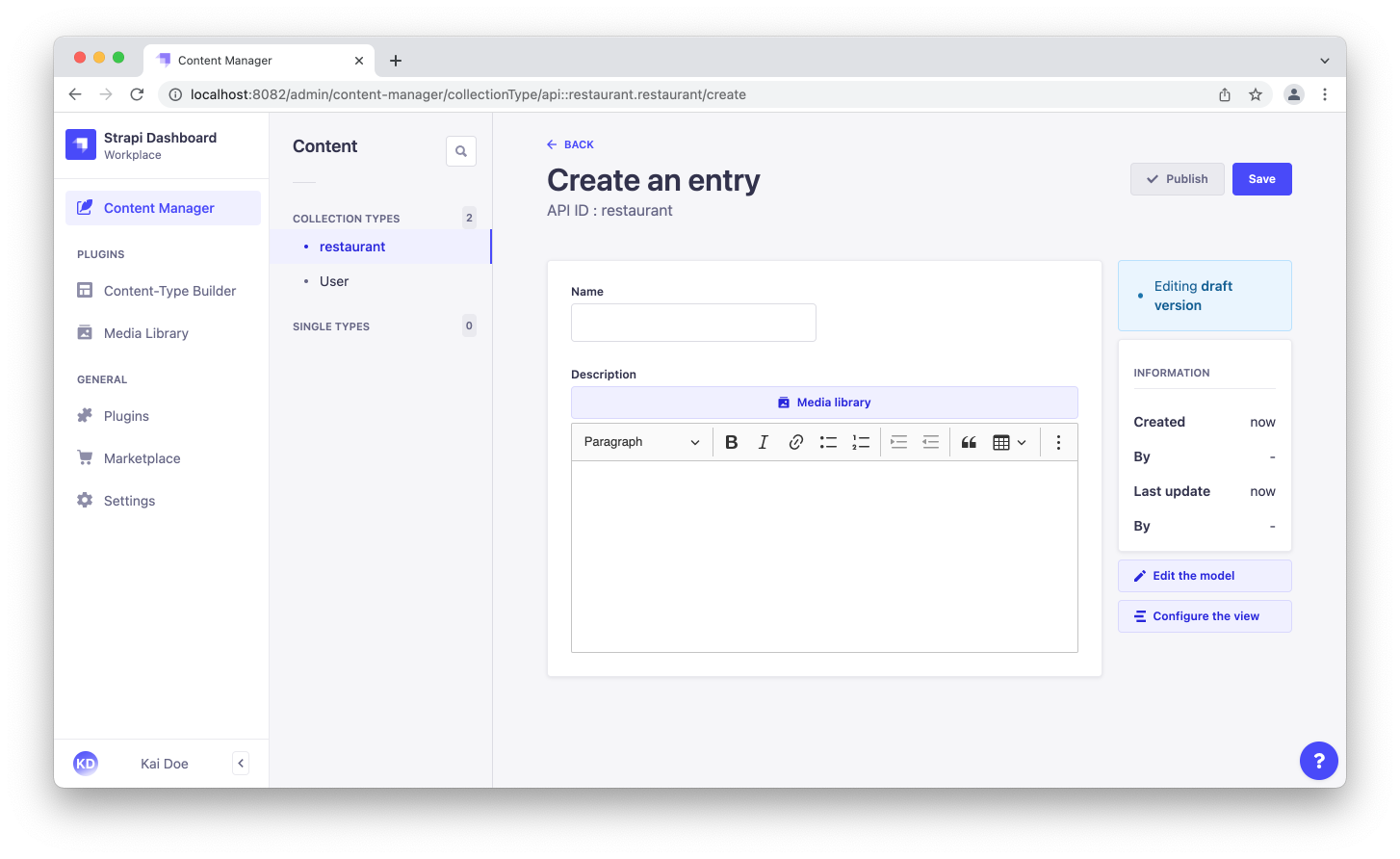# Creating a new WYSIWYG field in the admin panel
In this guide we will see how you can create a new field for the admin panel.
For this example, we will replace the default WYSIWYG with CKEditor (opens new window) in the Content Manager by creating a new plugin that will add a new field in your application.
# Setting up the plugin
Create a new project:
Generate a plugin:
Enable the plugin by adding it to the plugins configurations file:
// path: ./config/plugins.js module.exports = { // ... 'wysiwyg': { enabled: true, resolve: './src/plugins/wysiwyg' // path to plugin folder }, // ... }Install the required dependencies:
Start the application with the front-end development mode:
✏️ NOTE
Launching the Strapi server in watch mode without creating a user account first will open localhost:1337 with a JSON format error. Creating a user on localhost:8081 prevents this alert.
We now need to create our new WYSIWYG, which will replace the default one in the Content Manager.
# Creating the WYSIWYG
In this part we will create 3 components:
- a
MediaLibcomponent used to insert media in the editor - an
Editorcomponent that uses CKEditor (opens new window) as the WYSIWYG editor - a
Wysiwygcomponent to wrap the CKEditor
The following code examples can be used to implement the logic for the 3 components:
Example of a MediaLib component used to insert media in the editor:
// path: ./src/plugins/wysiwyg/admin/src/components/MediaLib/index.js
import React from 'react';
import { prefixFileUrlWithBackendUrl, useLibrary } from '@strapi/helper-plugin';
import PropTypes from 'prop-types';
const MediaLib = ({ isOpen, onChange, onToggle }) => {
const { components } = useLibrary();
const MediaLibraryDialog = components['media-library'];
const handleSelectAssets = files => {
const formattedFiles = files.map(f => ({
alt: f.alternativeText || f.name,
url: prefixFileUrlWithBackendUrl(f.url),
mime: f.mime,
}));
onChange(formattedFiles);
};
if(!isOpen) {
return null
};
return(
<MediaLibraryDialog onClose={onToggle} onSelectAssets={handleSelectAssets} />
);
};
MediaLib.defaultProps = {
isOpen: false,
onChange: () => {},
onToggle: () => {},
};
MediaLib.propTypes = {
isOpen: PropTypes.bool,
onChange: PropTypes.func,
onToggle: PropTypes.func,
};
export default MediaLib;
Example of an Editor component using CKEditor as the WYSIWYG editor:
// path: ./src/plugins/wysiwyg/admin/src/components/Editor/index.js
import React from 'react';
import PropTypes from 'prop-types';
import styled from 'styled-components';
import { CKEditor } from '@ckeditor/ckeditor5-react';
import ClassicEditor from '@ckeditor/ckeditor5-build-classic';
import { Box } from '@strapi/design-system/Box';
const Wrapper = styled(Box)`
.ck-editor__main {
min-height: ${200 / 16}em;
> div {
min-height: ${200 / 16}em;
}
// Since Strapi resets css styles, it can be configured here (h2, h3, strong, i, ...)
}
`;
const configuration = {
toolbar: [
'heading',
'|',
'bold',
'italic',
'link',
'bulletedList',
'numberedList',
'|',
'indent',
'outdent',
'|',
'blockQuote',
'insertTable',
'mediaEmbed',
'undo',
'redo',
],
};
const Editor = ({ onChange, name, value, disabled }) => {
return (
<Wrapper>
<CKEditor
editor={ClassicEditor}
disabled={disabled}
config={configuration}
data={value || ''}
onReady={editor => editor.setData(value || '')}
onChange={(event, editor) => {
const data = editor.getData();
onChange({ target: { name, value: data } });
}}
/>
</Wrapper>
);
};
Editor.defaultProps = {
value: '',
disabled: false
};
Editor.propTypes = {
onChange: PropTypes.func.isRequired,
name: PropTypes.string.isRequired,
value: PropTypes.string,
disabled: PropTypes.bool
};
export default Editor;
Example of a Wysiwyg component wrapping CKEditor:
// path: ./src/plugins/wysiwyg/admin/src/components/Wysiwyg/index.js
import React, { useState } from 'react';
import PropTypes from 'prop-types';
import { Stack } from '@strapi/design-system/Stack';
import { Box } from '@strapi/design-system/Box';
import { Button } from '@strapi/design-system/Button';
import { Typography } from '@strapi/design-system/Typography';
import Landscape from '@strapi/icons/Landscape';
import MediaLib from '../MediaLib';
import Editor from '../Editor';
import { useIntl } from 'react-intl';
const Wysiwyg = ({ name, onChange, value, intlLabel, disabled, error, description, required }) => {
const { formatMessage } = useIntl();
const [mediaLibVisible, setMediaLibVisible] = useState(false);
const handleToggleMediaLib = () => setMediaLibVisible(prev => !prev);
const handleChangeAssets = assets => {
let newValue = value ? value : '';
assets.map(asset => {
if (asset.mime.includes('image')) {
const imgTag = `<p><img src="${asset.url}" alt="${asset.alt}"></img></p>`;
newValue = `${newValue}${imgTag}`
}
// Handle videos and other type of files by adding some code
});
onChange({ target: { name, value: newValue } });
handleToggleMediaLib();
};
return (
<>
<Stack size={1}>
<Box>
<Typography variant="pi" fontWeight="bold">
{formatMessage(intlLabel)}
</Typography>
{required &&
<Typography variant="pi" fontWeight="bold" textColor="danger600">*</Typography>
}
</Box>
<Button startIcon={<Landscape />} variant='secondary' fullWidth onClick={handleToggleMediaLib}>Media library</Button>
<Editor
disabled={disabled}
name={name}
onChange={onChange}
value={value}
/>
{error &&
<Typography variant="pi" textColor="danger600">
{formatMessage({ id: error, defaultMessage: error })}
</Typography>
}
{description &&
<Typography variant="pi">
{formatMessage(description)}
</Typography>
}
</Stack>
<MediaLib
isOpen={mediaLibVisible}
onChange={handleChangeAssets}
onToggle={handleToggleMediaLib}
/>
</>
);
};
Wysiwyg.defaultProps = {
description: '',
disabled: false,
error: undefined,
intlLabel: '',
required: false,
value: '',
};
Wysiwyg.propTypes = {
description: PropTypes.shape({
id: PropTypes.string,
defaultMessage: PropTypes.string,
}),
disabled: PropTypes.bool,
error: PropTypes.string,
intlLabel: PropTypes.shape({
id: PropTypes.string,
defaultMessage: PropTypes.string,
}),
name: PropTypes.string.isRequired,
onChange: PropTypes.func.isRequired,
required: PropTypes.bool,
value: PropTypes.string,
};
export default Wysiwyg;
# Registering the field
The last step is to register the wysiwyg field with the Wysiwyg component using addFields(). Replace the content of the admin/src/index.js field of the plugin with the following code:
// path: ./src/plugins/wysiwyg/admin/src/index.js
import pluginPkg from "../../package.json";
import Wysiwyg from "./components/Wysiwyg";
import pluginId from "./pluginId";
const name = pluginPkg.strapi.name;
export default {
register(app) {
app.addFields({ type: 'wysiwyg', Component: Wysiwyg });
app.registerPlugin({
id: pluginId,
isReady: true,
name,
});
},
bootstrap() {},
};
And voilà, if you create a new collection type or single type with a rich text field you will see the implementation of CKEditor (opens new window) instead of the default WYSIWYG:

